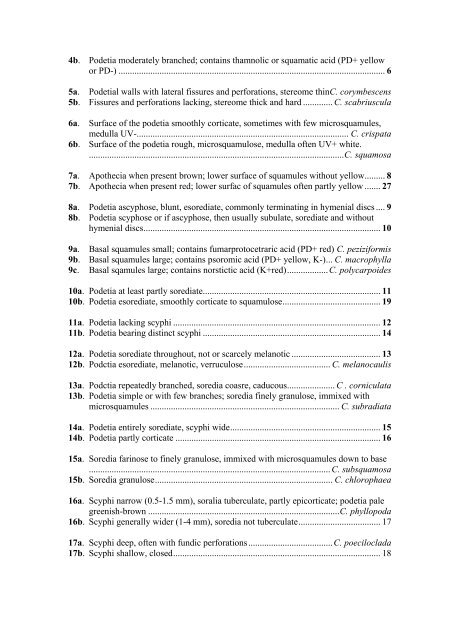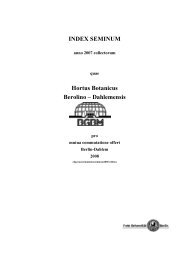Keys to the macrolichens and checklist of the lichens and ...
Keys to the macrolichens and checklist of the lichens and ...
Keys to the macrolichens and checklist of the lichens and ...
Create successful ePaper yourself
Turn your PDF publications into a flip-book with our unique Google optimized e-Paper software.
4b. Podetia moderately branched; contains thamnolic or squamatic acid (PD+ yellow<br />
or PD-) ..................................................................................................................... 6<br />
5a. Podetial walls with lateral fissures <strong>and</strong> perforations, stereome thinC. corymbescens<br />
5b. Fissures <strong>and</strong> perforations lacking, stereome thick <strong>and</strong> hard ............. C. scabriuscula<br />
6a. Surface <strong>of</strong> <strong>the</strong> podetia smoothly corticate, sometimes with few microsquamules,<br />
medulla UV-............................................................................................. C. crispata<br />
6b. Surface <strong>of</strong> <strong>the</strong> podetia rough, microsquamulose, medulla <strong>of</strong>ten UV+ white.<br />
................................................................................................................C. squamosa<br />
7a. Apo<strong>the</strong>cia when present brown; lower surface <strong>of</strong> squamules without yellow......... 8<br />
7b. Apo<strong>the</strong>cia when present red; lower surfac <strong>of</strong> squamules <strong>of</strong>ten partly yellow ....... 27<br />
8a. Podetia ascyphose, blunt, esorediate, commonly terminating in hymenial discs .... 9<br />
8b. Podetia scyphose or if ascyphose, <strong>the</strong>n usually subulate, sorediate <strong>and</strong> without<br />
hymenial discs........................................................................................................ 10<br />
9a. Basal squamules small; contains fumarpro<strong>to</strong>cetraric acid (PD+ red) C. peziziformis<br />
9b. Basal squamules large; contains psoromic acid (PD+ yellow, K-)... C. macrophylla<br />
9c. Basal sqamules large; contains norstictic acid (K+red)..................C. polycarpoides<br />
10a. Podetia at least partly sorediate.............................................................................. 11<br />
10b. Podetia esorediate, smoothly corticate <strong>to</strong> squamulose........................................... 19<br />
11a. Podetia lacking scyphi ........................................................................................... 12<br />
11b. Podetia bearing distinct scyphi .............................................................................. 14<br />
12a. Podetia sorediate throughout, not or scarcely melanotic ....................................... 13<br />
12b. Podctia esorediate, melanotic, verruculose...................................... C. melanocaulis<br />
13a. Podctia repeatedly branched, soredia coasre, caducous..................... C . corniculata<br />
13b. Podetia simple or with few branches; soredia finely granulose, immixed with<br />
microsquamules ................................................................................... C. subradiata<br />
14a. Podetia entirely sorediate, scyphi wide.................................................................. 15<br />
14b. Podetia partly corticate .......................................................................................... 16<br />
15a. Soredia farinose <strong>to</strong> finely granulose, immixed with microsquamules down <strong>to</strong> base<br />
.......................................................................................................... C. subsquamosa<br />
15b. Soredia granulose.............................................................................. C. chlorophaea<br />
16a. Scyphi narrow (0.5-1.5 mm), soralia tuberculate, partly epicorticate; podetia pale<br />
greenish-brown ....................................................................................C. phyllopoda<br />
16b. Scyphi generally wider (1-4 mm), soredia not tuberculate.................................... 17<br />
17a. Scyphi deep, <strong>of</strong>ten with fundic perforations.....................................C. poeciloclada<br />
17b. Scyphi shallow, closed........................................................................................... 18




